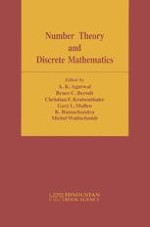
2002 | OriginalPaper | Buchkapitel
Multiple Polylogarithms: An Introduction
verfasst von : M. Waldschmidt
Erschienen in: Number Theory and Discrete Mathematics
Verlag: Hindustan Book Agency
Enthalten in: Professional Book Archive
Aktivieren Sie unsere intelligente Suche, um passende Fachinhalte oder Patente zu finden.
Wählen Sie Textabschnitte aus um mit Künstlicher Intelligenz passenden Patente zu finden. powered by
Markieren Sie Textabschnitte, um KI-gestützt weitere passende Inhalte zu finden. powered by
Multiple polylogarithms in a single variable are defined by <math display='block'> <mrow> <mi>L</mi><msub> <mi>i</mi> <mrow> <mrow><mo>(</mo> <mrow> <msub> <mi>s</mi> <mn>1</mn> </msub> <mo>,</mo><mo>⋯</mo><mo>,</mo><msub> <mi>s</mi> <mi>k</mi> </msub> </mrow> <mo>)</mo></mrow> </mrow> </msub> <mrow><mo>(</mo> <mi>z</mi> <mo>)</mo></mrow><mo>=</mo><mstyle displaystyle='true'> <munder> <mo>∑</mo> <mrow> <msub> <mi>n</mi> <mn>1</mn> </msub> <mo>></mo><msub> <mi>n</mi> <mn>2</mn> </msub> <mo>></mo><mo>⋯</mo><mo>></mo><msub> <mi>n</mi> <mi>k</mi> </msub> <mo>≥</mo><mn>1</mn> </mrow> </munder> <mrow> <mfrac> <mrow> <msup> <mi>z</mi> <mrow> <msub> <mi>n</mi> <mn>1</mn> </msub> </mrow> </msup> </mrow> <mrow> <msubsup> <mi>n</mi> <mn>1</mn> <mrow> <msub> <mi>s</mi> <mn>1</mn> </msub> </mrow> </msubsup> <mo>⋯</mo><msubsup> <mi>n</mi> <mi>k</mi> <mrow> <msub> <mi>s</mi> <mi>k</mi> </msub> </mrow> </msubsup> </mrow> </mfrac> </mrow> </mstyle> </mrow> </math>$$L{i_{\left( {{s_1}, \cdots ,{s_k}} \right)}}\left( z \right) = \sum\limits_{{n_1} > {n_2} > \cdots > {n_k} \geqslant 1} {\frac{{{z^{{n_1}}}}} {{n_1^{{s_1}} \cdots n_k^{{s_k}}}}}$$, when s1, … , s k are positive integers and z a complex number in the unit disk. For k = 1, this is the classical polylogarithm Li s (z). These multiple polylogarithms can be defined also in terms of iterated Chen integrals and satisfy shuffle relations. Multiple polylogarithms in several variables are defined for s i ≥ 1 and |z i | < 1(1 ≤ i ≤ k) by <math display='block'> <mrow> <mi>L</mi><msub> <mi>i</mi> <mrow> <mrow><mo>(</mo> <mrow> <msub> <mi>s</mi> <mn>1</mn> </msub> <mo>,</mo><mo>⋯</mo><mo>,</mo><msub> <mi>s</mi> <mi>k</mi> </msub> </mrow> <mo>)</mo></mrow> </mrow> </msub> <mrow><mo>(</mo> <mrow> <msub> <mi>z</mi> <mn>1</mn> </msub> <mo>,</mo><mo>⋯</mo><msub> <mi>z</mi> <mi>k</mi> </msub> </mrow> <mo>)</mo></mrow><mo>=</mo><mstyle displaystyle='true'> <munder> <mo>∑</mo> <mrow> <msub> <mi>n</mi> <mn>1</mn> </msub> <mo>></mo><msub> <mi>n</mi> <mn>2</mn> </msub> <mo>></mo><mo>⋯</mo><mo>></mo><msub> <mi>n</mi> <mi>k</mi> </msub> <mo>≥</mo><mn>1</mn> </mrow> </munder> <mrow> <mfrac> <mrow> <msubsup> <mi>z</mi> <mn>1</mn> <mrow> <msub> <mi>n</mi> <mn>1</mn> </msub> </mrow> </msubsup> <mo>⋯</mo><msubsup> <mi>z</mi> <mi>k</mi> <mrow> <msub> <mi>n</mi> <mi>k</mi> </msub> </mrow> </msubsup> </mrow> <mrow> <msubsup> <mi>n</mi> <mn>1</mn> <mrow> <msub> <mi>s</mi> <mn>1</mn> </msub> </mrow> </msubsup> <mo>⋯</mo><msubsup> <mi>n</mi> <mi>k</mi> <mrow> <msub> <mi>s</mi> <mi>k</mi> </msub> </mrow> </msubsup> </mrow> </mfrac> </mrow> </mstyle> </mrow> </math>$$L{i_{\left( {{s_1}, \cdots ,{s_k}} \right)}}\left( {{z_1}, \cdots {z_k}} \right) = \sum\limits_{{n_1} > {n_2} > \cdots > {n_k} \geqslant 1} {\frac{{z_1^{{n_1}} \cdots z_k^{{n_k}}}} {{n_1^{{s_1}} \cdots n_k^{{s_k}}}}}$$, and they satisfy not only shuffle relations, but also stuffle relations. When one specializes the stuffle relations in one variable at z = 1 and the stuffle relations in several variables at z1 = ⋯ = z k = 1, one gets linear or quadratic dependence relations between the Multiple Zeta Values <math display='block'> <mrow> <mi>ζ</mi><mrow><mo>(</mo> <mrow> <msub> <mi>s</mi> <mn>1</mn> </msub> <mo>,</mo><mo>⋯</mo><mo>,</mo><msub> <mi>s</mi> <mi>k</mi> </msub> </mrow> <mo>)</mo></mrow><mstyle displaystyle='true'> <munder> <mo>∑</mo> <mrow> <msub> <mi>n</mi> <mn>1</mn> </msub> <mo>></mo><msub> <mi>n</mi> <mn>2</mn> </msub> <mo>></mo><mo>⋯</mo><mo>></mo><msub> <mi>n</mi> <mi>k</mi> </msub> <mo>≥</mo><mn>1</mn> </mrow> </munder> <mrow> <mfrac> <mn>1</mn> <mrow> <msubsup> <mi>n</mi> <mn>1</mn> <mrow> <msub> <mi>s</mi> <mn>1</mn> </msub> </mrow> </msubsup> <mo>⋯</mo><msubsup> <mi>n</mi> <mi>k</mi> <mrow> <msub> <mi>s</mi> <mi>k</mi> </msub> </mrow> </msubsup> </mrow> </mfrac> </mrow> </mstyle> </mrow> </math>$$\zeta \left( {{s_1}, \cdots ,{s_k}} \right)\sum\limits_{{n_1} > {n_2} > \cdots > {n_k} \geqslant 1} {\frac{1} {{n_1^{{s_1}} \cdots n_k^{{s_k}}}}}$$ which are defined for k, s1, … ,s k positive integers with s1 ≥ 2. The Main Diophantine Conjecture states that one obtains in this way all algebraic relations between these MZV.